Tree-kangaroo
Tree-kangaroos are marsupials of the genus Dendrolagus, adapted for arboreal locomotion. They inhabit the tropical rainforests of New Guinea and far northeastern Queensland, along with some of the islands in the region. Most tree-kangaroos are considered threatened due to hunting and habitat destruction. They are the only true arboreal macropods.[1]
| Tree-kangaroo | |
|---|---|
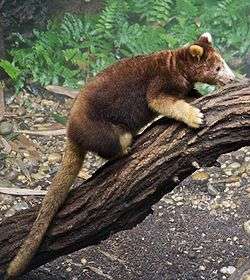 | |
| Matschie's tree-kangaroo (Dendrolagus matschiei) | |
| Scientific classification | |
| Kingdom: | Animalia |
| Phylum: | Chordata |
| Class: | Mammalia |
| Infraclass: | Marsupialia |
| Order: | Diprotodontia |
| Family: | Macropodidae |
| Subfamily: | Macropodinae |
| Genus: | Dendrolagus Müller, 1840 |
| Type species | |
| Dendrolagus ursinus Müller, 1840 | |
| Species | |
|
About 12; see text | |
Evolution
The evolutionary history of tree-kangaroos begins with a rainforest floor-dwelling pademelon-like ancestor.[2] This ancestor evolved from an arboreal possum-like ancestor as is suspected of all macropodid marsupials in Australia and New Guinea. During the late Eocene, the Australian/New Guinean continent began a period of drying that caused a retreat in the area of rainforest,[3] which forced the ancestral pademelons to begin living in a dryer, rockier environment. After some generations of adaptation to the new environment, the pademelons evolved into rock-wallabies (Petrogale spp.),[2] which developed a generalist feeding strategy due to their dependence on a diverse assortment of vegetation refuges.[4] This generalist strategy allowed the rock-wallabies to easily adapt to malesian rainforest types that were introduced to Australia from Asia during the mid-Miocene.[2][3] The rock-wallabies that migrated into these introduced forests adapted to spend more time climbing trees. One species in particular, the proserpine rock-wallaby (Petrogale persephone), displays equal preference for climbing trees as for living in rocky outcrops.[2] During the Late Miocene the semi-arboreal rock-wallabies evolved into the now extinct tree-kangaroo genus Bohra.[5] Global cooling during the Pleistocene caused continent-wide drying and rainforest retractions in Australia and New Guinea.[6] The rainforest contractions isolated populations of Bohra which resulted in the evolution of today's tree-kangaroos (Dendrolagus spp.), as they adapted to lifestyles in geographically small and diverse rainforest fragments, and became further specialized for a canopy-dwelling lifestyle.[7]
Taxonomy
Species
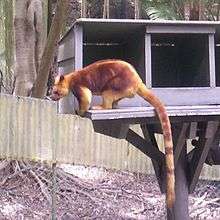
These species are assigned to the genus Dendrolagus:[8]
- Grizzled tree-kangaroo, D. inustus; northern and western New Guinea, plus the island of Yapen, and possibly Salawati and Waigeo
- Lumholtz's tree-kangaroo, D. lumholtzi; Queensland
- Bennett's tree-kangaroo, D. bennettianus; Queensland
- Ursine tree-kangaroo, D. ursinus; Vogelkop, New Guinea
- Matschie's tree-kangaroo, D. matschiei; Huon Peninsula, New Guinea
- Doria's tree-kangaroo, D. dorianus; western, central, and southeastern New Guinea
- Seri's tree-kangaroo, D. stellarum; highlands of west-central New Guinea
- Hoser's tree-kangaroo, D. hoserae; highlands of Mimika, West Papua
- Goodfellow's tree-kangaroo, D. goodfellowi; central and southeastern New Guinea
- Golden-mantled tree-kangaroo, D. pulcherrimus; Foja and Torricelli Mountains, New Guinea
- Lowlands tree-kangaroo, D. spadix; southwestern lowlands of Papua New Guinea
- Dingiso, D. mbaiso; highlands of west-central New Guinea
- Tenkile, D. scottae; Sandaun Province, New Guinea
- Wondiwoi tree-kangaroo, D. mayri; the higher areas of the Wondiwoi Peninsula (thought to be extinct until 2018)[9]
Seri's tree-kangaroo (Dendrolagus stellarum) has been described as a subspecies of Doria's tree-kangaroo (D. dorianus),[10][11] but some recent authorities have treated it as a separate species based on its absolute diagnostability.[8]
The Wondiwoi tree-kangaroo is among the 25 “most wanted lost” species that are the focus of Global Wildlife Conservation's “Search for Lost Species” initiative.[12]
The case for the golden-mantled tree-kangaroo (D. pulcherrimus) is comparable to that of D. stellarum; it was first described as a subspecies of D. goodfellowi,[10] though recent authorities have elevated it to species status based on its absolute diagnostability.[8] A population of the tenkile (Scott's tree-kangaroo) recently discovered from the Bewani Mountains may represent an undescribed subspecies.[13]
Distribution and habitat
Tree-kangaroos inhabit the tropical rainforests of New Guinea, far northeastern Australia, and some of the islands in the region, in particular, the Schouten Islands and the Raja Ampat Islands.[14] Although most species are found in mountainous areas, several also occur in lowlands, such as the aptly named lowlands tree-kangaroo. Most tree-kangaroos are considered threatened due to hunting and habitat destruction. Because much of their lifestyle involves climbing and jumping between trees, they have evolved an appropriate method of locomotion. Tree-kangaroos thrive in the treetops, as opposed to terrestrial kangaroos which survive on mainland Australia. Two species of tree-kangaroos are found in Australia, Bennett's (D. bennetianus), which is found north of the Daintree River and Lumholtz's (D. lumholtzi). Tree-kangaroos have adapted better to regions of high altitudes.[15] At least 14 known subspecies of tree-kangaroo are living in Papua New Guinea and Australia. Tree-kangaroos must find places comfortable and well-adapted for breeding, as they only give birth to one joey per year. They are known to have one of the most relaxed and leisurely birthing seasons. They breed cautiously in the treetops during the monsoon season. Their habitats are breeding grounds for danger, as they can easily fall prey to their natural predator, the amethystine python, which also climbs and lives in the treetops. Tree-kangaroos are known to be able to live in both mountainous regions and lowland locations.[16]
Description
Lumholtz's tree-kangaroo is the smallest of all tree-kangaroos. Its body and head length ranges about 48–65 cm, and its tail, 60–74 cm, with males weighing an average of 7.2 kg (16 lb) and females 5.9 kg (13 lb). The length of Doria's tree-kangaroo is 51–78 cm, with a long 44–66 cm tail, and weighs 6.5–14.5 kg. Matschie's tree-kangaroo has a body and head length of 81 cm (20 to 32 inches), adult males weigh 9–11 kg (20-25 lb) and adult females weigh 7–9 kg (15-20 lb). The grizzled tree-kangaroo grows to a length of 75–90 cm (30 to 35 in), with males being considerably larger than females, and its weight is 8–15 kg (18-33 lb).
Tree-kangaroos have several adaptations to an arboreal life-style. Compared to terrestrial kangaroos, tree-kangaroos have longer and broader hind feet with longer, curved nails. They also have a sponge-like grip on their paws and soles of their feet. Tree-kangaroos have a much larger and pendulous tail than terrestrial kangaroos, giving them enhanced balance while moving about the trees. Locomotion on the ground is by hopping, as with true kangaroos. Like terrestrial kangaroos, tree-kangaroos do not sweat to cool their bodies, rather, they lick their forearms and allow the moisture to evaporate in an adaptive form of behavioural thermoregulation.[17]
Behaviour
Locomotion
Tree-kangaroos are slow and clumsy on the ground. They move at approximately human walking pace and hop awkwardly, leaning their body far forward to balance the heavy tail. However, in trees, they are bold and agile. They climb by wrapping their forelimbs around the trunk of a tree and, while allowing the forelimbs to slide, hop up the tree using their powerful hind legs. They are expert leapers; 9 metres (30 ft) downward jumps from one tree to another have been recorded and they have the extraordinary ability to jump to the ground from 18 metres (59 ft) or more without being hurt.
Diet
The main diet of the tree-kangaroo is leaves and fruit that it gathers from the trees, but occasionally scavenged from the ground. Tree-kangaroos will also eat grains, flour, various nuts, sap and tree bark.[17] Some captive tree-kangaroos (perhaps limited to New Guinea species) eat protein foods such as eggs, birds and snakes, making them omnivores.[2]
Reproduction
Little is known about the reproduction of tree-kangaroos in the wild. The only published data are from captive individuals.[18] Female tree-kangaroos reach sexual maturity as early as 2.04 years of age and males at 4.6 years. The female's fertile period is estimated to be approximately two months. They have one of the longest marsupial offspring development/maturation periods; pouch life for the young is 246–275 days long and weaning occurs 87–240 days later.[19]
Orphan
At the Adelaide Zoo, an orphaned tree-kangaroo joey was transferred to the pouch of a yellow-footed rock-wallaby when his mother was killed by a falling branch in November 2014. The joey survived, having been successfully reared by the surrogate mother rock-wallaby.[20]
Threats
The two most significant threats to tree-kangaroos are habitat loss and hunting. Tree-kangaroo habitats are being destroyed or replaced by logging and timber production, along with coffee, rice and wheat production. This habitat loss can make tree-kangaroos more exposed to predators such as feral domestic dogs. Being hunted by local community members also contributes markedly to the declines in tree-kangaroo populations.[17] Research conducted on Lumholtz's tree-kangaroo, a species that dwells in the rain forests of northeastern Australia, determined the frequency of causes of death. This showed that of 27 deceased tree-kangaroos, 11 had been killed by vehicles, six by dogs, four by parasites and the remaining six died from other causes.[21]
Gallery
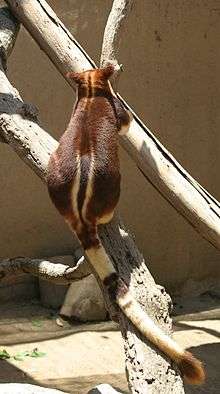 The back and tail of a Buergers' tree-kangaroo (Dendrolagus goodfellowi buergersi)
The back and tail of a Buergers' tree-kangaroo (Dendrolagus goodfellowi buergersi)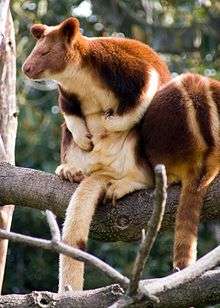 Two Goodfellow's tree-kangaroos, (Dendrolagus goodfellowi)
Two Goodfellow's tree-kangaroos, (Dendrolagus goodfellowi)- Lumholtz's tree-kangaroo (Dendrolagus lumholtzii)
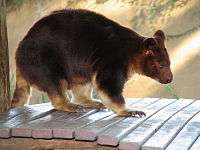 Buergers' tree-kangaroo (Dendrolagus goodfellowi buergersi)
Buergers' tree-kangaroo (Dendrolagus goodfellowi buergersi)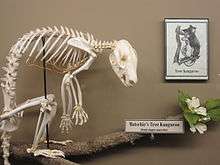 A Matschie's tree-kangaroo (Dendrolagus matschiei) skeleton
A Matschie's tree-kangaroo (Dendrolagus matschiei) skeleton
See also
References
- Procter-Gray, E. & Gansiosser, U. (1987). "The individual behaviors of Lumholtz's Tree-Kangaroo: Repertoire and taxonomic iTree-kangaroosmplications". Journal of Mammalogy. 67 (2): 343–352. doi:10.2307/1380888. JSTOR 1380888.
- Roger Martin, ed. (2005). Tree-kangaroos of Australia and New Guinea. CSIRO Publishing. ISBN 978-0-643-09072-9.
- Archer, Mike (1991). Riversleigh: The Story of Animals in Ancient Rainforest of Inland Australia. Bangowlah, NSW: Reed Books.
- Tuft, KD; Crowther, M.S.; McArthur, C. (2011). "Multiple scales of diet selection of brush-tailed rock-wallabies (Petrogale penicillata)". Australian Mammalogy. 33 (2): 169–180. doi:10.1071/am10041.
- Flannery, Timothy; Martin, Roger; Szalay, Alexandra (1996). Tree-kangaroos: A Curious Natural History. Melbourne VIC: Reed Books. pp. 68–72. ISBN 978-0-7301-0492-6.
- Hopkins, M. S.; J. Ash; A. W. Graham; J. Head; R. K. Hewitt (1993). "Charcoal evidence of the spatial extent of the Eucalyptus woodland expansions and rainforest contractions in North Queensland during the late Pleistocene". Journal of Biogeography. 20 (4): 357–372. doi:10.2307/2845585. JSTOR 2845585.
- Prideaux, G. J., Warburton, N.M. (2010). Macropods. Collingwood, VIC: CSIRO. pp. 137–151.
- Groves, C. P. (2005). Wilson, D. E.; Reeder, D. M. (eds.). Mammal Species of the World: A Taxonomic and Geographic Reference (3rd ed.). Baltimore: Johns Hopkins University Press. pp. 59–61. ISBN 0-801-88221-4. OCLC 62265494.
- Solly, Meilan (27 September 2018). "Elusive Tree Kangaroo Spotted for First Time in 90 Years". Smithsonian. Retrieved 12 October 2018.
- Flannery, T. (1995). Mammals of New Guinea. Reed Books. ISBN 978-0-7301-0411-7.
- Nowak, R., ed. (1999). Walker's Mammals of the World (6th ed.). Johns Hopkins University Press. ISBN 978-0-8018-5789-8.
- "The Search for Lost Species". Global Wildlife Conservation. Retrieved 2 June 2017.
- Tenkile Tree Kangaroo Archived 2014-02-25 at the Wayback Machine Tenkile Conservation Alliance
- "Matschie's Tree Kangaroos, Matschie's Tree Kangaroo Pictures, Matschie's Tree Kangaroo Facts - National Geographic". Animals.nationalgeographic.com. 23 October 2013. Retrieved 13 November 2013.
- Sullivan, R. (2007). "Treetop kangaroos". ABC.net.au. Retrieved 27 May 2015.
- "Tree Kangaroo - Animal Facts and Information". Bioexpedition.com. Retrieved 13 November 2013.
- "WWF - Tree Kangaroo". Wwf.panda.org. Retrieved 13 November 2013.
- "Tree-Kangaroo and Mammal Group - helping to conserve North Queensland's rich mammal fauna - TREE KANGAROO INFO". Tree-kangaroo.net. Archived from the original on 29 October 2013. Retrieved 13 November 2013.
- Johnson, P.M. & Delean, S. (2003). "Reproduction of Lumholtz's tree-kangaroo, Dendrolagus lumholtzi (Marsupialia : Macropodidae) in captivity, with age estimation and development of the pouch young". Wildlife Research. 30 (5): 505–512. doi:10.1071/wr02090.
- Adelaide Zoo transfer orphaned joey surrogate wallaby mother - ABC News - 30 June 2015.
- Chambers, J. "Lumholtz Tree-kangaroo". Rainforest-australia.com. Retrieved 27 May 2015.
External links
| Wikispecies has information related to Dendrolagus |
| Wikimedia Commons has media related to: |